Are you one of those people who fell in love with Thai cuisine and then found themselves studying the Thai language? I can’t blame you for that because who wouldn’t like Thai food?
So today we have a great post for you about Thai food vocabulary. We’ve listed the most useful Thai food terms, cooking terms for Thai cuisine, plus the most popular Thai food (such as Pad Thai) in the Thai restaurants. Just keep reading for detailed vocabulary about these topics!
Southern Thai Food
Spices are an essential part of Southern Thai cuisine, so those who are a fan of intense flavor should visit the south of Thailand where the foods are much spicier and hotter than the foods in Northern Thailand.
Nearly every meal is eaten with rice everywhere in Thailand so there is at least one rice cooker in Thai houses. In the south, soft-boiled rice is very common as the main dish. Jasmine rice is also preferred.
Southern Thailand has a lot more rain than the north, which brings an abundance of coconuts. Coconut milk is added to many popular dishes, including curries and soups, which makes them thick and flavorsome.
Northern Thai Food
In Northern Thailand, they prefer steamed sticky rice. They use fingers to roll the rice into a ball, then dip it into a spicy dip sauce, it’s also really good with crispy and boiled vegetables.
Unlike the south, curries tend to be thinner in the north where they usually use a broth or stock. Also, in the north, the nearest ocean is hundreds of miles away, therefore seafood is not as common as it is in Southern Thailand. People use chicken and pork instead of seafood.
Thai Food Vocabulary You Need To Learn
Fruits
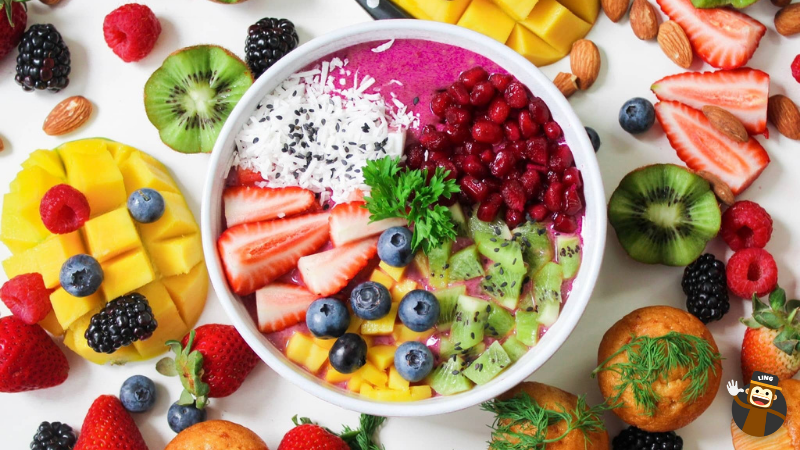
Fruits can be grown almost anywhere in Thailand and the county is rich in terms of growing fruits and vegetables. Some of the fruits in this list may be unfamiliar to you since there are many delicious fruits that are unique to Thailand but we tried to collect the most popular ones among Thai people.
- mango (มะม่วง – má-mûang)
- coconut (มะพร้าว– má-práao)
- pineapple (สับปะรด – sàp-bpà-rót)
- banana (กล้วย – glûay)
- papaya (มะละกอ – má lá gor)
- durian (ทุเรียน – tú rian)
- mangosteen (มังคุด – mang kút)
- rambutan (เงาะ – ngór)
- longan (ลำไย – lam-yai)
- rose apple (ชมพู่ – chom-pôo)
- guava (ฝรั่ง – fà-ràng)
- dragonfruit (แก้วมังกร – gâew mang-gon)
- pomelo (ส้มโอ – sôm oh)
- tamarind (มะขาม – má kăam)
- jackfruit (ขนุน – ka-nŭn)
- strawberry (สตรอว์เบอร์รี่ – sà-dtror-ber-rêe)
- lychee (ลิ้นจี่ – lín jèe)
- watermelon (แตงโม – dtaeng moh)
- starfruit (มะเฟือง – má feuang)
- persimmon (ลูกพลับ – lôok-pláp)
Vegetables

Vegetables are one of the core elements of Thai cuisine. Most Thai foods are based on vegetables along with meat or seafood, especially in southern Thai cuisine. So, here is the list of vegetables in Thai.
- tomato (มะเขือเทศ – má-kĕua tâyt)
- lettuce (ผักกาดหอม – pàk gàat hŏm)
- onion (หอมหัวใหญ่ – hŏm hŭa yài)
- spinach (ผักโขม – pàk kŏm)
- cucumber (แตงกวา – dtaeng-gwaa)
- potato (มันฝรั่ง – man fà-ràng)
- sweet potato (มันเทศ – man tâyt)
- broccoli (บร็อคโคลี่ – brawk ko lee)
- chinese broccoli (บร็อคโคลี่จีน – brawk ko lee cīn)
- cauliflower (กะหล่ำดอก – gà-làm dòk)
- beans (ถั่ว – tùa)
- mushroom (เห็ด – hèt)
- corn (ข้าว โพด – kâao pôht)
- garlic (กระเทียม – grà tiam)
- carrot (แครอท – kae-rôt)
- pumpkin (ฟักทอง – fák tong)
- asparagus (หน่อไม้ฝรั่ง – nòr máai fà-ràng)
- shallot (หอมแดง– hŏm daéng)
- morning glory (ผักบุ้ง – pàk bûng)
- chilli (พริก – prík)
- lemongrass (ตะไคร้ – dtà-krái)
- cabbage (กะหล่ำปลี – gà-làm bplee)
- ginger (ขิง – kĭng)
- bamboo shoots (หน่อไม้ – nòr máai)
- watercress (ผักน้ำ – pàk nám)
- Thai eggplant (มะเขือยาว – má-kĕua yaao)
- rice noodles (ก๋วยเตี๋ยว – kwyteiyw)
- rice flour (แป้งข้าวจ้าว – paeng khaw caw)
Meat & Seafood
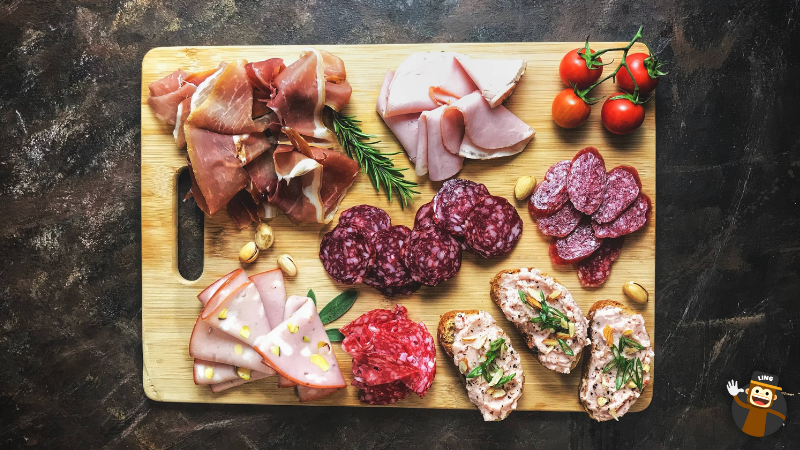
As we mentioned above, one of the main ingredients of Thai cuisine is meat and seafood. Anything that comes from the sea can turn into a tasty Thai dish. Meat is also seen as a perfect match with a noodle dish by Thai people. So, here is the list of meat and seafood in Thai.
- meat (เนื้อสัตว์ – néua sàt)
- chicken (ไก่ – gài)
- chicken wing (ปีกไก่ – bpèek gài)
- beef (เนื้อวัว – néua wua)
- pork (หมู – mŏo)
- mutton (เนื้อแกะ – néua gàe)
- duck (เป็ด – bpèt)
- sausage (ไส้กรอก – sâi gròk)
- bacon (เบคอน – bay-kon)
- ham (แฮม – haem)
- turkey (ไก่งวง – gài nguang)
- ribs (ซี่โครง – sêe krohng)
- meatball (ลูกชิ้น – lôok chín)
- bullfrog (กบนา – gòp naa)
- seafood (อาหาร ทะเล – aa hăan tá-lay)
- fish (ปลา – bplaa)
- salmon (ปลาแซลม่อน – bplaa saen-mon)
- shrimp/prawn (กุ้ง – gûng)
- shrimp paste (กะปิ – kapi)
- lobster (กุ้งก้ามกราม – gûng gâam graam)
- tuna (ปลาทูน่า – bplaa too-nâa)
- crab (ปู – bpoo)
- oyster (หอยนางรม – hŏi naang rom)
- squid (ปลาหมึก – bplaa mèuk)
- catfish (ปลากด – bplaa gòt)
- fishball (ลูกชิ้นปลา – lôok chín bplaa)
- egg (ไข่ – khi)
- fried egg (ไข่ดาว – khidāw)
- boiled egg (ไข่ต้ม – khi t̂im)
- fish sauce (น้ำปลา – naplā)
- bean sprouts (ถั่วงอก – thạ̀wngk)
Popular Thai Dishes – อาหารไทยยอดนิยม (A-han thai yod niyom)
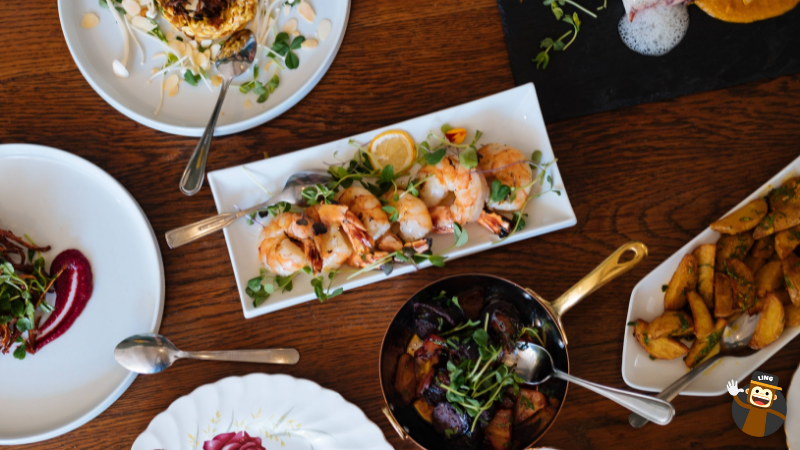
There are numerous Thai restaurants all over the world that help us to meet with amazing Thai-style foods. For me, the best one is Pad Thai. So if there is a Thai restaurant in your town, I highly recommend you to taste it as well as other Thai foods.
- sticky rice (ข้าวเหนียว – kâao nĭeow)
- fried rice (ข้าวผัด – kâao pàt)
- pork and rice omelet (ข้าวไข่เจียวทรงเครื่อง – kâao kài jieow song krêuang)
- Hainanese chicken rice (ข้าวมันไก่ – kâao man gài)
- roast red duck on rice (ข้าวหน้าเป็ด – kâao nâa bpèt)
- Pad Thai (ผัดไทย – pàt tai)
- Khao Soi (ข้าวซอย – kâao soi)
- egg noodle soup with red roast pork (บะหมี่หมูแดง – bà-mèe mŏo daeng)
- drunken noodles (ก๋วยเตี๋ยวผัดขี้เมา – gŭay-dtĭeow pàt kêe mao)
- Pad see ew (ผัดซีอิ๊ว – pàt-see-íw) – noodles stir-fried w/ soy sauce
- yellow curry (แกงกะหรี่ – gaeng gà rèe)
- green curry (แกงเขียวหวาน – gaeng kĭeow wăan)
- red curry (แกงเผ็ด – gaeng pèt)
- Phanaeng curry (แกงพะแนง – gaeng pá-naeng)
- Massaman curry (แกงมัสมั่น – gaeng mát-sà-màn)
- Tom Yum Goong (ต้มยำกุ้ง – dtôm yam gûng)
- papaya salad (ส้มตำ – sôm dtam)
- Pad Ka-Prao (ผัดกะเพรา – pàt gà prao) – stir fried pork w/ holy basil
- Tom Kha Gai (ต้มข่าไก่ – dtôm-kàa gài) – Thai coconut soup
- chicken with cashew nuts (ไก่ผัดเม็ดมะม่วง – gài pàt mét má-mûang)
Drinks
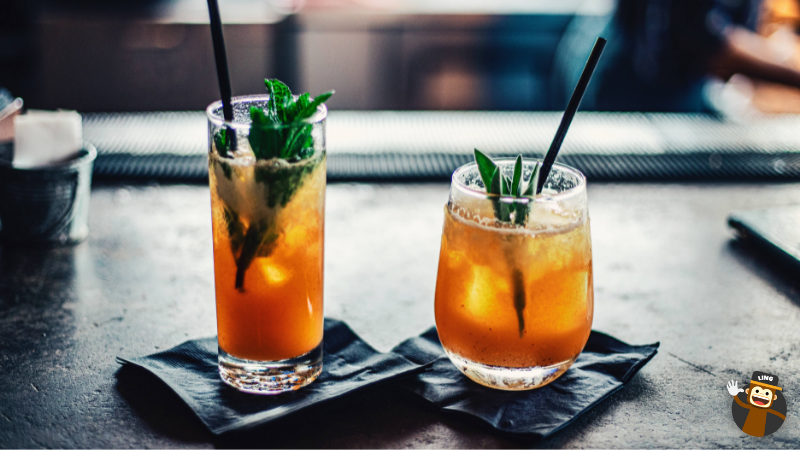
In Thailand, cold and iced drinks are more preferred by people since the weather is usually hot there. This vocabulary list would be really useful when you go to a fancy cafe or grocery shop in Thailand. Let’s have a look at drinks in Thai.
- water (น้ำ – nám)
- tea (ชา – chaa)
- iced tea (ชาเย็น – chaa yen)
- hot tea (ชาร้อน – chaa rón)
- coffee (กาแฟ – gaa fae)
- iced coffee (กาแฟเย็น – gaa-fae yen)
- hot coffee (กาแฟร้อน – gaa-fae rón)
- fruit juice (น้ำผลไม้ – nám pŏn-lá-máai)
- orange juice (น้ำส้ม – nám sôm)
- lime juice (น้ำมะนาว – nám má-naao)
- coconut milk (น้ำมะพร้าว – nám má-práao)
- smoothie (น้ำผลไม้ปั่น – nám pŏn-lá-máai bpàn)
- milk (นม – nom)
- soda (โซดา – soh daa)
- Coke (โค้ก – kóhk)
- beer (เบียร์ – bia)
- wine (ไวน์ – wai)
- red wine (ไวน์แดง – wai daeng)
- white wine (ไวน์ขาว – wai kăao)
- liquor/spirits (สุรา – sù raa)
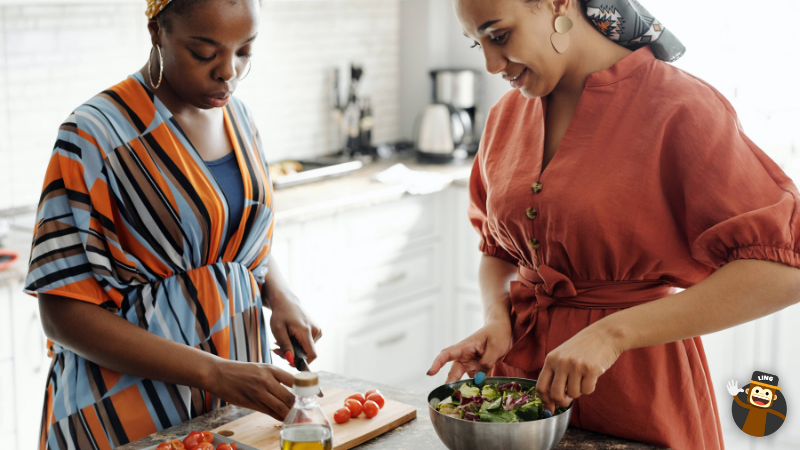
In this vocabulary list, we gathered the most frequently used Thai cooking terms in the kitchen. These words could be easier to memorize if you think about them or say them aloud while cooking in the kitchen.
- baked – อบ (ob)
- fried – ทอด (tod)
- grilled – ย่าง (ỳāng)
- roasted – คั่ว (khạ̀w)
- steamed – นึ่ง (nụ̀ng)
- warm – อุ่น (oun)
- bitter – ขม (K̄hm)
- salty – เค็ม (khĕm)
- spicy – เผ็ด (p̄hĕd)
- sweet – หวาน (h̄wān)
Thai Cooking Utensils
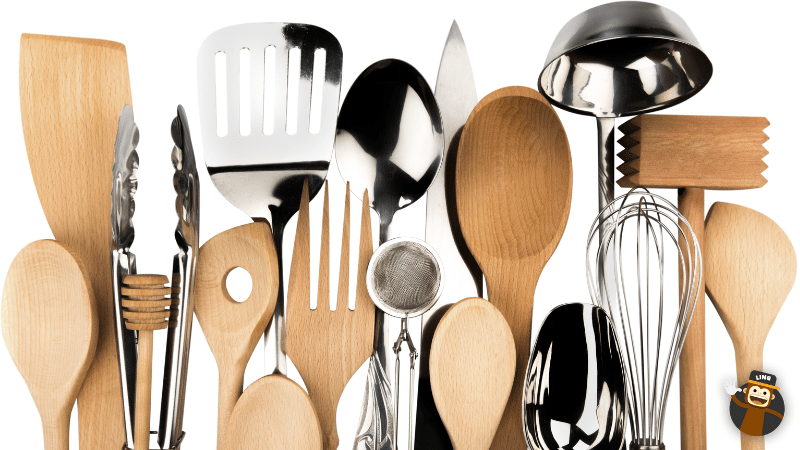
I was really surprised when I found out Thai people have such cool cooking utensils in their kitchen. They are super useful and practical. Here are the most frequently used cooking utensils in Thailand.
- Mortar and pestle ครกและสาก (khrok sak)
- Coconut shredder เครื่องขูดมะพร้าว (kratai kood maprao)
- Sticky rice basket ตะกร้าข้าวเหนียว (gratib)
- Wok กระทะ (grata)
- Straw basket for steaming sticky rice ตะกร้าฟาง (huad neung khao niew)
- Cleaver มีด (ee-to)
- Chopping block เขียง (kieng)
- Steamer เรือกลไฟ (maw neung)
- Brass pot for desserts หม้อทองเหลือง (mor tong luang)
Thai Food Terms
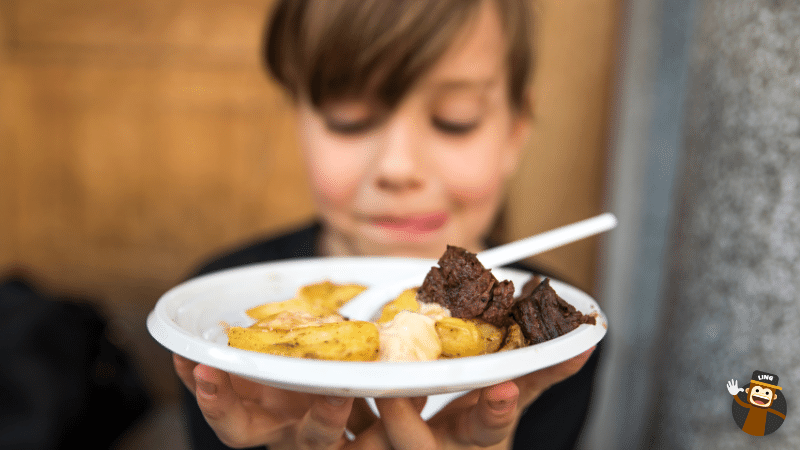
You can use these food-related words to define what does the food taste like and express your comment about it. Also, you will be able to tell people if you are following a special diet such as vegan or vegetarian.
- Allergic แพ้ (Pay)
- Vegan มังสวิรัติ (Jae)
- Vegetarian มังสวิรัติ (Mawng sa vee rat)
- Hungry หิว (Hiu)
- Salty เค็ม (Kem)
- Spicy เผ็ด (Pet )
- Sweet หวาน (Waan)
- Sour เปรี้ยว (Bpriao)
Useful Dining Phrases

If you have a limited language level in the Thai language, these are the casual phrases that can save you when you go dining outside in Thailand or when you are invited for the dinner by a Thai friend. They are pretty simple so you can just go over them quickly.
- yes – ใช่ (chı̀/chai)
- no – ไม่ (mị̀/mai)
- good – ดี (dī)
- yummy – อร่อย (xr̀xy/arroy)
- eat – กิน (kin)
- cook – ปรุงอาหาร (prung xāh̄ār/prung ahan)
- I’m hungry – ฉันหิว (C̄hạn h̄iw)
- I’m full – ฉันอิ่มแล้ว (C̄hạn xìm læ̂w)
- more – มากกว่า (mākkẁā)
- less – น้อยกว่า (N̂xy kẁā/noi kwa)
- only – เท่านั้น (Thèānận/taw naan)
- please – กรุณา (Kruṇā/karunaa)
- thank you – ขอบคุณ (K̄hxbkhuṇ/kaw coon
Do You Want To Learn The Thai Language?
If you want to explore the Thai Language, improving your knowledge of the most commonly used words and phrases will make a huge difference in speaking Thai. That’s why we advise you to use the Ling App to master your Thai language.

The Ling App by Simya Solutions is an online language learning app that guarantees to help you move from a total beginner into a confident Thai language speaker. The app has a number of scientifically recognized language learning methods to help you increase your level by using the app for just 15 minutes a day! Download it now to learn Thai and 60+ other languages! You can get it from the Play Store or App Store for free!



























